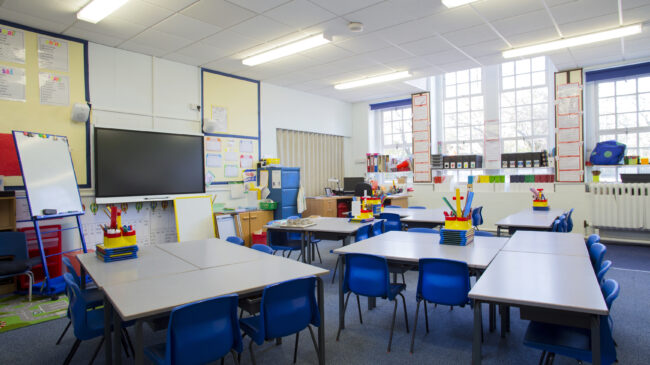In the past year, Congress has rushed more than $204 billion in federal emergency funds to states to support K-12 schools. But 23 states had fewer incoming students this fall. This declining enrollment is obviously due, in part, to COVID-19 pandemic-related trends but is also a symptom of changing birth rates and families geographically relocating.
Long-term losses in enrollment can have grave financial ramifications for school districts. Fewer students mean smaller budgets because state education funding formulas typically use enrollment to determine how many dollars a school district will receive each year. Despite declining enrollment and less per-pupil funding, states and school districts are still obligated to fund expensive staff and retiree benefit programs. These programs usually have enormous costs for school districts due, in part, to underfunded teacher pensions.
For many schools losing students, vast portions of their already shrinking budgets go to paying off growing pension debts. Data finds that public education employer retirement contributions increased from an average of less than $600 per pupil in the U.S. in 2002 to $1,600 per pupil in 2019.
While spending on employee benefits has steadily increased since 2002, salary expenditures have remained essentially flat. In fact, according to Reason Foundation’s K-12 Spending Spotlight, per-pupil spending on instructional staff benefits increased by more than 75% on average, and support service staff benefits also grew by nearly 80% per pupil. But salary spending only increased by $153 per student.
Unfortunately for teachers, the increased spending on retirement packages hasn’t resulted in better benefits since most of the money is funneled to pension debt. But it should be noted that increased education spending in some states, like South Carolina, has led to better-funded pension systems.
However, in other states, student enrollment has not kept pace with public pension obligations. For instance, enrollment in New York state declined by more than 300,000 students between 2002 and 2019. Despite serving fewer students, New York increased salary and benefits spending for support services and instructional staff. During that time, per-pupil spending on support services staff grew by 55% and by 53.7% for instructional staff. Spending on benefits for instructional staff skyrocketed as New York spent an additional $3,348 per pupil in 2019 than it did in 2002, increasing education expenditures on teacher benefits by more than 147% since 2002.
New York’s scenario, unfortunately, is not an anomaly. States such as Pennsylvania and Illinois also witnessed massive losses in their K-12 enrollments since 2002, losing 200,000 and 100,000 students respectively. Yet, despite serving fewer students, public pension obligations have forced the states to increase education spending on instructional staff. In fact, both states increased their per-pupil expenditures on instructional staff benefits by 177.7% and 174.7% respectively.
As Chad Aldeman pointed out in Education Next, “Teachers have by far the highest retirement costs, even compared with other public-sector employees. While the average civilian employee receives $1.92 per hour worked for retirement benefits, teachers receive $7.38 per hour in retirement compensation.”
States that are facing declining enrollment should be adaptive and rightsize their education spending. The fact that school districts lost more than 1.4 million K-12 students in 2020 during the COVID-19 pandemic — nearly a three percent dip in enrollment — poignantly emphasizes the need for greater funding flexibility.
However, underfunded teacher pension systems that require large debt payments are a barrier to rightsizing and reallocating their education spending. Reason Foundation’s Pension Integrity Project notes that “this pension debt not only takes funding away from classrooms but could also put future benefits and pay increases in jeopardy.”
Underfunded pension obligations will continue to funnel money away from classrooms and students unless governments begin to undertake public pension reforms that create a plan to pay off existing pension debt and reduce future risk, as Texas did with its state employees plan in the 2021 legislative session. Texas now needs to make similar reforms to the Teacher Retirement System.
Currently, Wisconsin and South Dakota are the only states that have fully funded teacher pension systems.
States should start their pension reform efforts by lowering their overly optimistic assumed rates of investment return. Public pension plans have historically fallen short of their own investment expectations, which drives pension debt. Financial experts project that despite outstanding investment returns in 2021, future rates of return will be lower.
Policymakers should also provide better communication and transparency to teachers about their pension systems to disclose how underfunded their benefits are. For instance, Alaska, Delaware, Maine, Minnesota, and North Dakota provide teachers with projections for the future contributions that are necessary to pay off the systems’ total unfunded liabilities.
States that properly fund their teacher pension liabilities and design effective teacher retirement systems for the future will be able to better serve students and make education dollars more flexible for future generations. Teacher pension reforms that prioritize realistic expectations and transparency are the key to sustainable and student-centered education spending.
A version of this column first appeared in RealClearEducation.
Stay in Touch with Our Pension Experts
Reason Foundation’s Pension Integrity Project has helped policymakers in states like Arizona, Colorado, Michigan, and Montana implement substantive pension reforms. Our monthly newsletter highlights the latest actuarial analysis and policy insights from our team.

